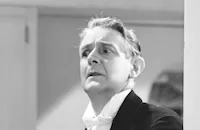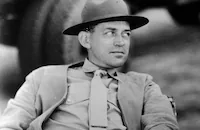Rage in Heaven

Brief Synopsis
Cast & Crew
W. S. Van Dyke Ii
Robert Montgomery
Ingrid Bergman
George Sanders
Lucile Watson
Oscar Homolka
Film Details
Technical Specs

Synopsis
In a London hotel, engineer Ward Andrews is surprised to encounter his old college roommate, Philip Monrell, who has just returned from Paris. Philip invites Ward to come to his country estate, where they both meet pretty Stella Bergen, Philip's mother's new secretary. Mrs. Monrell, who worries that her wastrel son neglects his work at the family steel mill, hopes that Stella, whom she has grown to love like a daughter, will marry Philip. Stella likes Philip, but is more attracted to the stable, hard-working Ward. Philip appears to encourage the two, but is happy when Ward has to leave. After Ward's departure, Mrs. Monrell says that she is traveling to Africa for her health and Philip must run the mill. That night, when Philip expresses his insecurities, Stella's encouragement makes him feel that he can do what his "always right" mother wants, and he reveals that while in Paris, he used Ward's name and felt that he was a better person because of it. He then tenderly proposes and a touched Stella accepts. Six weeks after their marriage, Philip reluctantly goes to work at the mill, but before he leaves, he hides Stella's beloved kitten in his briefcase, jealous because the animal was a gift from Ward. Later, to impress her, he orchestrates an executive meeting, but his ridiculous comments so anger the chief engineer that the man resigns. That evening, Clark, the butler, reveals that Stella's missing kitten was found with a broken neck near the mill. Her grief so upsets Philip that he erupts in a rage, but later apologizes and begs her never to leave him. She asks him never to mention Ward's name again, but while she is sleeping, he writes in his diary that he will ask Ward to become his new chief engineer. When Ward visits, she is very formal, knowing that Philip is watching, and says that she is very happy. She is surprised and upset when Philip convinces Ward to become his engineer. Some weeks later, after Philip leaves on a business trip, Ward tries to tell Stella his concerns about Philip, but she angrily refuses to talk with him. The next day, she apologizes and he reveals that Philip is too severe with the men. She confides her fear that Philip is trying to kill their love, then reluctantly agrees to dine with Ward at the local hotel. Their innocent dinner is interrupted by Philip, who says he just returned, and listens to Ward's proposal for a new housing project for his workers. After brusquely saying that it is obedience, not respect he wants, Philip goes to pay the bill, which reveals that he had been staying at the hotel the entire time. When labor unrest erupts at the mill, Ward tries in vain to have Philip call off the summoned police, but as an angry mob storms the office, Philip realizes his danger and tells Ward to give them anything they want. He then flees, leaving Ward and Stella to face the men. The next day, Philip pretends to be contrite and goes to the plant with Ward, but once there, he tries to push Ward into a slag vat. That night, Ward quarrels with Philip and admits that he loves Stella, then leaves, asking her to let him know if she ever needs him. Stella now realizes that Philip's paranoia is so advanced that she, too, must leave. She sneaks away and goes to the hotel, where she tells Ward that Philip is mad. While they are talking, Philip calls and says that he will give her a divorce, but wants to talk to Ward about it at the house. Despite Stella's misgiving, Ward goes to the house and upon his arrival, he and Philip start a heated argument which is overheard by Clark. After Philip suggests that they end their relationship amicably, Ward leaves and Philip immediately sets a plan in motion in which he commits suicide by impaling himself on a knife after ransacking his study to make it appear as if he had been killed. When the body is later found, Ward is tried and convicted of murder because Philip had tricked Ward into putting his fingerprints on the knife. On the day before Ward is to be executed, Stella is visited by Dr. Rameau, a Parisian psychiatrist who had just learned about the case the day before. He reveals that after seeing Philip's picture in the newspaper, he recognized him as a man suffering from extreme paranoia whom he had treated at his clinic under the name "Ward Andrews." Rameau is convinced that Philip, who escaped the clinic, killed himself and, like most paranoids, may have bragged about his accomplishment by leaving some type of message or diary. With Clark's help, Stella and Rameau search the house until they are interrupted by Mrs. Monrell. Although she blames Stella for Philip's death, she finally admits that Philip's father had committed suicide and reveals that Philip always kept a diary. When they learn that the most recent diary had been sent to Paris to be rebound on the day of Philip's death, they rush to Paris, and the diary's revealing contents saves Ward from execution. Some time later, Stella and Ward throw the diary off the ship on which they are sailing.

Cast

Robert Montgomery

Ingrid Bergman

George Sanders

Lucile Watson

Oscar Homolka

Philip Merivale
Matthew Boulton
Aubrey Mather
Frederic Worlock
Francis Compton

Gilbert Emery
Ludwig Hart

Lawrence Grant
Art Dupuis
Victor Kendall
Eldon Gorst
Guy Kingsford
Olaf Hytten
David Clyde
Pat Moriarity
Frank Shannon

Harry Cording
Bobby Hale
Leyland Hodgson
Damian O'flynn
Eric Lonsdale
Dave Thursby
Pat O'malley
Lillian Kemble-cooper

Leonard Carey
Joe North
Major George C. Mcbride
Stuart Hall
Clive Morgan
Wyndham Standing
Arthur Stuart Hull

Holmes Herbert
John Burton
Harry Allen
Colin Kenny
Jean Del Val
Crew
Adrian
Hugh Boswell
George Folsey
Cedric Gibbons
Eddie Imazu
Christopher Isherwood
Bronislau Kaper
Harold F. Kress
Oliver T. Marsh
Gottfried Reinhardt
Douglas Shearer
Robert Thoeren
Richard Thorpe
Edwin B. Willis

Videos
Movie Clip



Trailer
Film Details
Technical Specs

Articles
Rage in Heaven
The male leads, Robert Montgomery and George Sanders, intriguingly play against type in Rage in Heaven. Montgomery usually portrayed likeable characters, and Sanders usually played unscrupulous cads. Because Montgomery had played another psychopath once before to great success in MGM's Night Must Fall (1937), he felt that the studio was trying to pigeonhole him into another similar role in hopes of repeating his triumph. According to Ingrid Bergman in her 1980 autobiography My Story, Montgomery had a plan to rebel. He came to her one day before shooting began and warned her that he had no plans to act in Rage in Heaven. "I'm very sorry to do this to you," he told her, "but I'm forced to do this movie, so I intend to just say the lines but not act." Eventually he explained that he was staging this protest out of sheer exhaustion. He was under a seven-year contract with MGM and felt he was being overworked. He had asked the studio not to send him straight into another picture and requested some time off, but they had said no. "If I refuse," Montgomery continued in his explanation to Bergman, "they'll suspend me without pay. I've got a wife, children, a big house, a swimming pool, I need the money...But I'm going to make my protest."
Shooting began on Rage in Heaven under the direction of Robert Sinclair. In keeping with his plan, Robert Montgomery played every line and every scene completely monotone and flat. He also pretended not to hear Sinclair when he attempted to direct him. After two weeks of this, Sinclair quit the picture. MGM responded by bringing in veteran director W.S. "One-Take Woody" Van Dyke, a man known for getting the job done quickly and economically.
Ingrid Bergman had heard that Van Dyke was tough, and she didn't like him or his boot camp methods at all. Robert Montgomery continued his "non-acting" protest while Bergman just tried to do her best and get through the picture. Co-star George Sanders was simply fed up with all the nonsense and slept most of the time. "He would come out from his dressing room yawning," recalls Ingrid Bergman in her autobiography, "do his little bit, and go back to sleep again. He couldn't care less about it."
Bergman became unhappy enough on the set to go to David O. Selznick, who had loaned her out to MGM to make Rage in Heaven, and ask him to have Van Dyke replaced as the director or have her removed from the picture altogether. Selznick, however, encouraged her to stick it out, saying that it wasn't his place to have directors replaced on other studios' pictures. She knew that he had accepted a lot of money to loan her out, so Bergman returned to making Rage in Heaven and planned to get through it the best she could.
One day later Van Dyke visited Bergman's dressing room, and she used the opportunity to tell him exactly what she thought of his rigid methods. "Why don't you stay with the army," she said, "the way you go on marching and yelling? You don't know anything about people's feelings...You are certainly not interested in anything but 'finish the picture,' no matter what sort of picture it is. You don't give us any possibility of acting; you don't give us any advice on that at all. Why don't you put on roller skates so you can go quicker from one place to another?"
Van Dyke was floored by Bergman's outburst. He said how dare she talk to her director like that and threatened to have her fired before storming out of her dressing room. Bergman told him that she hoped he did fire her, because that's exactly what she wanted. Later, Van Dyke returned to Bergman and vowed to try to improve his ways. "You know," he humbly told her before returning to work, "you are very good in this part."
For all the turmoil on the set of Rage in Heaven, it is invisible onscreen. George Sanders and Ingrid Bergman are wonderful to watch as they help spin the dark suspense yarn. Despite Robert Montgomery's "non-performance," he still received rave notices from critics, who apparently thought he could do no wrong.
Producer: Gottfried Reinhardt
Director: W.S. Van Dyke
Screenplay: Edward Chodorov, Christopher Isherwood, Robert Thoeren, James Hilton (novel)
Cinematography: Oliver T. Marsh, George J. Folsey
Film Editing: Harold F. Kress
Art Direction: Cedric Gibbons
Music: Bronislau Kaper
Cast: Robert Montgomery (Philip Monrell), Ingrid Bergman (Stella Bergen), George Sanders (Ward Andrews), Lucile Watson (Mrs. Monrell), Oskar Homolka (Dr. Rameau), Philip Merivale (Mr. Higgins).
BW-85m. Closed captioning.
by Andrea Passafiume

Rage in Heaven
Quotes
Trivia
W.S. Van Dyke took over the direction of the movie from Robert B. Sinclair, who became ill shortly after shooting began. Van Dyke was in the Marines, but was granted a 14-day leave to finish the picture. Neither Sinclair nor Van Dyke was available for retakes, which were then directed by Richard Thorpe (I).
Notes
Robert B. Sinclair began the direction of this film, but, according to Hollywood Reporter news items, W. S. Van Dyke II took over as the director when Sinclair became ill just before Christmas, 1940. Van Dyke, who was an officer in the U.S. Marines, was granted a fourteen-day leave to finish the picture, according to Hollywood Reporter. Because neither Sinclair nor Van Dyke was available for retakes, Richard Thorpe directed those scenes, but only Van Dyke is credited onscreen. According to news items in Hollywood Reporter, Ingrid Bergman was loaned to M-G-M for the film by David O. Selznick's company, and George Saunders was loaned by Twentieth Century-Fox for the film.

















